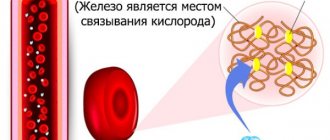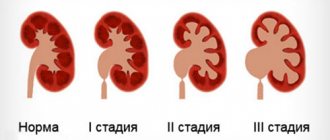Characteristics of the problem and types of symptoms
Hematuria is divided into 2 groups, namely macroscopic and microscopic:
- Macroscopic
. A significant amount of blood causing the urine to turn pink or red and the presence of blood clots visible to the naked eye characterizes macroscopic hematuria or gross hematuria. - Microscopic
. A small amount of impurities, invisible to the naked eye, is a manifestation of microscopic hematuria or microhematuria. Traces of it can only be detected through laboratory research.
Regardless of the type, the symptom in question sometimes indicates the presence of a serious disorder. This is a symptom that requires medical attention, regardless of age.
The presence of any number of impurities can be a symptom of a serious disease, even if the condition occurs only once.
If blood is detected in the urine, an immediate examination is required. Ignoring it can worsen the symptoms of serious diseases and cause untimely detection of a number of dangerous conditions, such as cancer, kidney disease, which are most often accompanied by this manifestation. As part of the examination, a special analysis is carried out, and appropriate additional tests are prescribed, such as CT, MRI, ultrasound. Their goal is to determine the cause of the problem. Only after it has been identified can appropriate treatment be applied.
How does hematuria form and what does it mean?
Hematuria is the presence of blood clots in the urine.
Normally, urine is straw-yellow in color and transparent. There are microhematuria and macrohematuria. Microhematuria is the appearance of red blood cells in the urine as a result of microscopy. It is almost impossible to notice blood in the urine with the naked eye. Microhematuria can be caused by excessive physical activity. It is not a pathological condition, because after rest it disappears. Macrohematuria is the presence of blood clots in the urine, visible without a microscope. The development of hematuria is facilitated by various injuries, infectious and inflammatory processes and other pathological conditions. This leads to thinning of the walls of capillary vessels, which burst. The result is the release of blood in urine.
Causes of disorder in old age
The most common cause of blood in an older man's urine is a urinary tract infection. Infection (inflammatory disease) can affect all organs of the excretory system (kidneys, bladder, ureter, urethra). Basically, the infection spreads upward (from the urethra gradually penetrates the bladder, and from there through the ureters to the kidneys).
The most common symptom of a urinary tract infection is pain, frequent urination, and blood when urinating in older men. Hematuria can be both macroscopic and microscopic. Left untreated, urinary tract infections can lead to life-threatening urosepsis.
But the symptom is also sometimes caused by excessive exercise. Temporary microscopic hematuria in old age occurs even after great effort, and disappears at rest. Prostate injury can occur particularly when riding a bicycle.” Some diseases, such as kidney stones, often first appear after exercise. In the case of trauma, bloody marks are usually associated with damage to the lumbar region or lower abdomen and are accompanied by pain at the site of the injury.
Diseases of the urinary system
A relatively common cause of the disorder is the presence of stones in the excretory tract, most often in the kidneys, ureters or bladder.
The presence of kidney stones is called nephrolithiasis, ureterolithiasis of the ureters and cystolithiasis of the bladder.
Urine stones are crystals formed from minerals and other substances found in urine. They are present in the kidneys and bladder, from where they can reach other parts of the excretory system and cause blockage. The resulting condition leads to hematuria, severe pain even outside of urination (renal colic).
The next, more dangerous reason is bladder cancer. This is a relatively uncommon type of cancer (incidence increases after age 50). The disease may cause bloody discharge, painful urination, or frequent urination and is treated with surgical removal, chemotherapy, immunotherapy, or radiation therapy.
Prostate diseases
In middle-aged and elderly men, a common cause of hematuria is an enlarged prostate gland (prostate). This is a gland located just below the bladder near the urethra.
When the prostate enlarges, it compresses the urethra, causing problems with urination (difficulty passing urine), preventing the bladder from emptying completely. This can lead to urinary tract infections resulting in the presence of blood in the urine.
A serious cause of bloody impurities is prostate cancer. This is the most common type of cancer affecting men. Unfortunately, the disease is very insidious. At first it doesn't show up at all. Only when the disease reaches an advanced stage does the patient begin to experience problems with urination, burning, pain when urinating, or the presence of blood in the urine. Prostate cancer is treated by surgical removal of the prostate, chemotherapy, radiation therapy or brachytherapy.
Kidney diseases
Another relatively common cause of hematuria is any kidney disease. These include:
- inflammation of the kidneys due to the infection mentioned above;
- kidney damage as a result of other diseases, in particular diabetes.
Rarely, a condition called poststreptococcal glomerulonephritis may occur, which also causes hematuria. The disease develops 1-2 weeks after an untreated streptococcal infection.
Fortunately, this disorder is quite rare today. The reduction in incidence is due to the fact that streptococcal infections (like strep throat) can be treated quickly and with almost no side effects using appropriate antibiotic drugs.
Other causes of hematuria include dangerous kidney cancer. Like prostate cancer, the presence of blood is usually not detected until late in the disease, so this symptom cannot be used as an early warning.
Complications of blood in urine
Excretion of blood in the urine in men is a condition that requires mandatory diagnosis, since in most cases it indicates the presence of serious problems. Diseases that cause hematuria can be successfully treated at the initial stage, but as they progress, they cause severe complications:
- Minor pain intensifies, pathological processes affect an increasingly larger area, spreading to nearby organs.
- In a man, in addition to malfunctions in the excretory system, sexual function is disrupted, libido decreases until it disappears completely.
- The presence of hematuria indicates the possibility of malignancy (transition to cancer) of benign formations.
- The risk of acute renal failure, pathological changes in all organs of the urinary system, and blood poisoning (sepsis) increases.
Hemophilia and drugs
The last possible cause of blood impurities is a disease called hemophilia. We are talking about a congenital or acquired bleeding disorder, often found in older people. This means that a person can be born with hemophilia or develop it during their lifetime. Men experience the disorder more often than women.
Hemophilia is manifested by the frequent appearance of bruises even after minor injuries. Treatment is based on the severity of the disease. Mild hemophilia is only controlled. For more severe conditions, it is necessary to administer a clotting factor concentrate, which is not found in the blood of people with hemophilia.
Coagulation disorders sometimes occur as a side effect of certain medications, such as:
- penicillin;
- aspirin;
- blood thinners (such as heparin or warfarin);
- cyclophosphamide (a medicine used to treat some types of cancer).
In addition, hematuria may occur with medications that contain sulfonamides or rifampicin. Rare causes of hematuria include diseases such as sickle cell anemia and Alport syndrome.
Substances that can change the color of urine
The color of human urine is affected by various foods and medications. It may appear reddish-brown in color, particularly after eating beets, blackberries or rhubarb. But this coloration can also be caused by medications, in particular the antiparasitic drug Pirvinium. Sometimes bloody impurities may appear after taking antibiotics or laxatives.
When dispensing a medicine or dietary supplement, the pharmacist must inform you about side effects in advance.
The presence of free hemoglobin (a protein loaded with iron) causes a condition known as hemoglobinuria. It is characterized by the presence of blood in a man’s urine without pain or other unpleasant symptoms.
In some cases, red blood cells break down and hemoglobin is released from them. Its excess is subsequently excreted from the body in urine, which turns red or brown.
Hemoglobinuria can also be caused by hemolytic anemia. In addition to hemoglobin, other substances produced by the human body can change the color of urine. For example, when a similar symptom appears, bilirubin is examined, the presence of which may indicate liver damage.
3.Diagnosis of the disease
Hematuria is often detected only by laboratory testing of urine, since with low-intensity blood discharge, the urine does not change color so significantly that it is noticeable. However, the content of red blood cells in the urine often causes a number of accompanying symptoms (pain, problems with urination, general weakness or fever). Since a urine test is a necessary test for any visit to a doctor, hematuria, even in the absence of a visible picture, is detected in the laboratory.
Further examination should be aimed at clarifying the causes of hematuria. This could be research such as:
- urine analysis according to Nechiporenko;
- assessment of the daily amount of urine in comparison with the volume of fluid drunk;
- microscopic examination of urine sediment, including phase-contrast microscopy;
- study of the shape and color of red blood cells in urine;
- Ultrasound of the pelvic organs;
- cystoscopy and biopsy;
- clinical blood test;
- bacteriological urine culture;
- radiography;
- computed and magnetic resonance imaging.
About our clinic Chistye Prudy metro station Medintercom page!
Diagnosis of hematuria
The basis of diagnosis is medical history. The doctor asks the patient a series of questions about the amount of blood in the urine, frequency of urination, pain or other discomfort. It is important to tell your doctor about any medications you are taking, as some medications may cause blood in the urine.
An integral part of the diagnosis is a physical examination and laboratory microbiological examination of urine, which confirms the presence of blood and can detect the causative agent of the disease (if the cause is infection).
If necessary, the doctor will advise the patient about the importance of additional examinations, such as:
- nephrogram (x-ray of the kidneys to determine stones in the urine);
- CT scan of the abdomen (to detect kidney stones, cancer and other diseases);
- ultrasound examination (to determine the presence of stones in the urine or other urinary tract diseases).
The next study that helps determine the cause of the disorder is cystoscopy. When examined through the urethra, a thin tube with a camera on the end is inserted into the bladder, through which the doctor can view the inside of the bladder and the canal to determine the cause of hematuria.
How to treat
When blood is detected in a man’s urine, the therapeutic course is aimed at eliminating the root cause and accompanying symptoms.
Infectious and inflammatory processes are controlled by antibacterial therapy and anti-inflammatory drugs. This allows you to destroy the cause of inflammation - the infectious pathogen.
A malignant neoplasm (depending on its shape and type) is eliminated surgically. Complex treatment includes hormonal, chemotherapy or radiation therapy.
Urolithiasis requires the mandatory introduction of a special treatment table and correction of the drinking regime. This allows you to normalize metabolic processes, reduce the load on the excretory system, and prevent the formation of new stones. For particularly large stones, procedures are prescribed that crush them into smallest elements.
Additionally, for any disease, antispasmodic, painkillers, anti-inflammatory drugs, and immunomodulators are prescribed.
The appearance of blood in a man’s urine is a signal of pathological processes. They are not always dangerous, but require mandatory diagnosis and monitoring by a urologist. Timely medical care will prevent the progression of the disease, complications and serious consequences.
When to seek medical help?
Although this is a frightening symptom, it does not always indicate a serious illness. Consultation with a doctor is required if impurities are visible, accompanied by problems with urination such as burning, pain or stinging, increased frequency of urination, abdominal or back pain. All of these symptoms may indicate microscopic hematuria.
Serious manifestations are the detection of blood clots, especially accompanied by such signs as:
- nausea;
- vomit;
- fever;
- chills;
- pain in the abdomen, back or side.
Ignoring the problem can have serious consequences. If this symptom is caused by cancer, the primary tumor may spread throughout the body, reducing the chances of cure.
Untreated infection can lead to urosepsis and kidney failure. Likewise, prostate enlargement should not be ignored due to the presence of a risk of urinary disorders (nocturia or nocturnal enuresis, inability to completely empty the bladder, pain when urinating, etc.) and, in severe cases, prostate cancer.
Urinary stones, which are responsible for causing blood impurities, can become lodged in the urinary tract, leading to renal colic. Therefore, it is necessary to undergo treatment. The goal of therapy is to break the stones into smaller pieces that are easier to remove from the body.
Examination for gross hematuria
As with all other symptoms, with hematuria the initial step is to take an anamnesis (questioning). The doctor asks about the time of occurrence of hematuria, possible causes (if the patient associates the developed condition with any cause), associated symptoms, provoking factors, etc. For example, in case of injuries, the patient will indicate a previous fall or blow, which will most likely allow the urologist to make a diagnosis at this stage.
It is extremely important to clarify about the medications that the patient is taking, for example, when taking rifampicin (an anti-tuberculosis drug), the urine becomes red-brown in color. In addition to medications, food products (beets) also change the color of urine.
Next, the patient should be examined - a physical examination should be performed. It is necessary to examine the patient to identify rashes, in particular, hemorrhagic ones (bruising), which may indicate blood diseases; during examination, one can also identify pallor (anemia), which is characteristic of prolonged blood loss. In addition, the lymph nodes are examined, the temperature is measured, the presence/absence of edema is checked, the abdomen is palpated (in 7% of cases it is possible to palpate a large kidney tumor), men undergo a digital rectal examination, and women are advised to consult a gynecologist.
After anamnesis has been collected and the patient has been examined, the urologist proceeds to laboratory and instrumental examinations necessary for an accurate diagnosis of the causes of gross hematuria. The entire spectrum is listed below, from the simplest to the most complex, modern methods.
Laboratory diagnosis of hematuria
The fastest and easiest way to make a topical diagnosis for hematuria is a two-glass test
, which allows you to roughly localize the source of bleeding. To carry out this test, you only need two glasses into which the patient urinates. Based on which glass there is an admixture of blood, the localization of the pathological focus causing bleeding will be determined.
A general urine test is required
, where they pay attention to protein, salts, presence/absence of bacteria and other pathologies that will help in making a diagnosis and choosing treatment tactics. A complete blood count will indicate the degree of anemia due to bleeding.
Instrumental diagnostic methods
- Ultrasound
is the easiest way to diagnose existing pathology that leads to hematuria; - cystoscopy
or
ureteropyelocalicoscopy
- if the patient has gross hematuria, emergency cystoscopy is indicated, with the help of which in most cases it is possible to diagnose the source of bleeding. If the latter is not localized in the bladder, then the blood ejected from the mouth of the ureter is used to localize the side and then, using ureteropyelocalicoscopy (examination of the ureter, pelvis and calyces of the kidney using a nephroscope), the cause is found; - MSCT
is an accurate method for diagnosing the source of bleeding.
Treatment of the symptom and underlying disorder
Treatment primarily focuses on the cause of the unpleasant condition. In exceptional cases, it is necessary to compensate for the loss of blood volume (for example, after serious injuries). Treatment may include antibiotic therapy to control the urinary tract infection. In addition, the doctor may prescribe medications to treat prostate enlargement and remove urinary stones.
The pharmacy dispenses medicines or nutritional supplements suitable for reducing the first signs of urinary tract infections, used after antibiotic treatment or to prevent recurrent infections (eg Urinal®, Uroval®, Urosept® capsules). They may contain cranberries, probiotics or D-mannose, a sugar that prevents bacteria from attaching to the bladder wall. Some preparations contain only D-mannose and are used for both acute and chronic problems.
Herbal mixtures and diuretic teas are also useful for the treatment of infectious diseases. They should not be taken continuously or for a long time, as they irritate the kidneys due to increased urine production, leading to kidney damage.
For an enlarged prostate, medications or nutritional supplements containing extracts of Serenoa repens or Saw palmetto (for example, Prostamol uno®, Prostakan forte®, Prostenal®) are prescribed. Pumpkin seed oil and nettle root extract are also recommended.
Hematuria is a symptom that requires attention
There are a number of disorders accompanied by the appearance of bloody impurities. In diabetic patients, urinary infections are more common in the presence of glucose in the urine; microscopic hematuria is a symptom of hypertension, as well as hematological diseases such as leukemia, sickle cell anemia, and bleeding disorders.
Hematuria also occurs with complex disorders, such as renal cysts, urolithiasis, and the presence of protein in the urine. This is a serious sign that should not be underestimated, especially in old age. The amount of clots or impurities often varies; often they may even disappear temporarily. Unfortunately, a painless symptom, even fluctuating, is a concomitant manifestation of tumors of the kidneys and urinary tract.
Modern medicine has a number of treatment options that can suppress the problem and the diseases that cause it. But the basis of therapy is timely examination, receiving professional medical care, and following the doctor’s advice.
How is hematorrhea treated?
When treating hematorrhea of bacterial origin, therapy with antibiotics, anti-inflammatory and wound-healing drugs is used, which are individually selected by the doctor. To determine the true cause of bleeding, a series of laboratory tests are performed to determine the presence of the infectious agent, microscopic examination of a smear, and cytoscopy. To exclude oncopathology, a test for tumor markers is taken and an ultrasound is performed.
Blood from the urethra
is a signal of many pathologies. But only a qualified medical approach and attentive attitude of the doctor will help to avoid them, which is the reason for contacting our clinic.
This article does not constitute medical advice and should not serve as a substitute for consultation with a physician.










